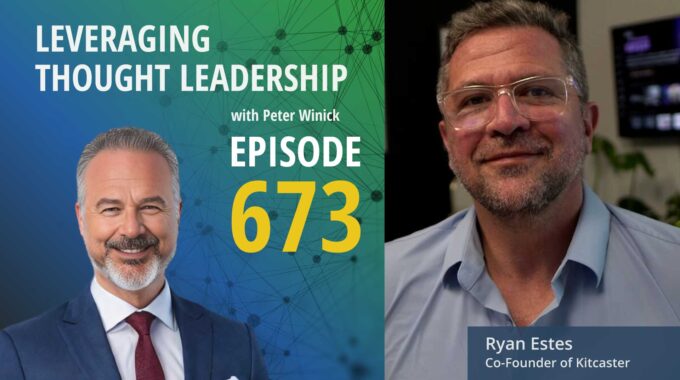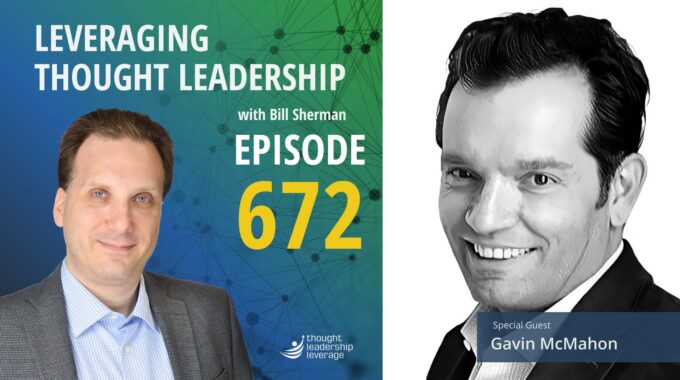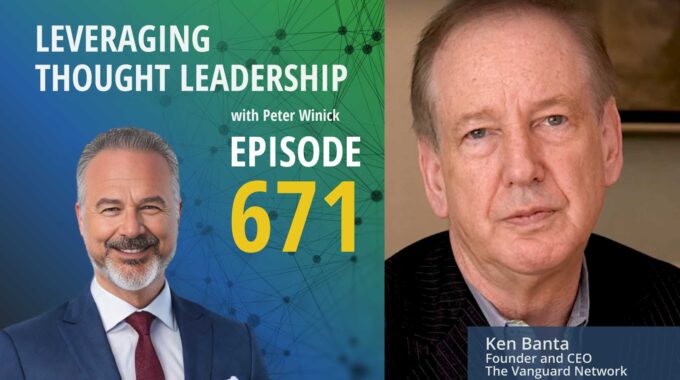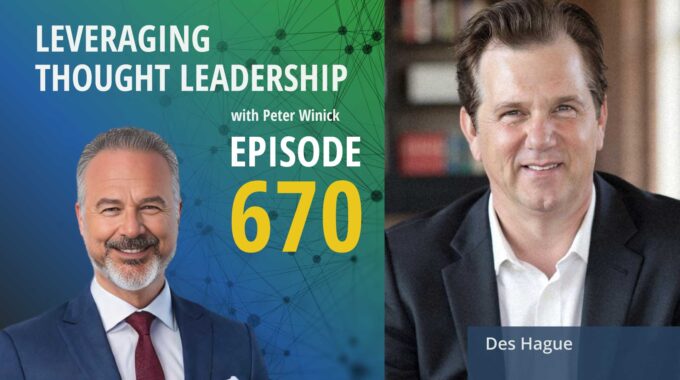Founder-led marketing, podcast strategy, and the art of authentic conversation What makes a podcast truly…
Leveraging Thought Leadership With Peter Winick – Episode 53 – Jan Rutherford
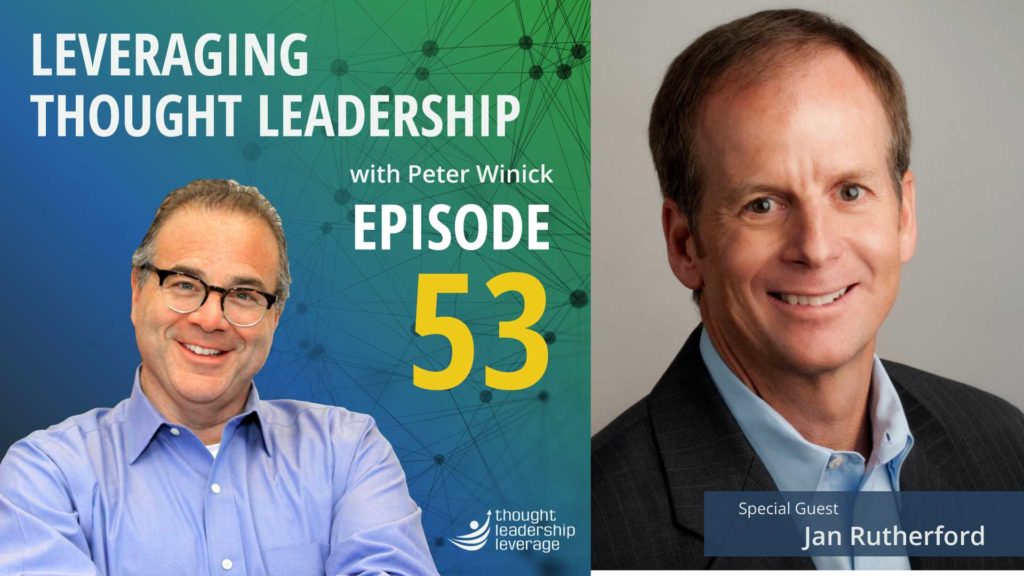
Each workplace has its own challenges. How can leaders be more effective at bringing their organization through a difficult time of growth?
Jan Rutherford, author of “The Littlest Green Beret” offers advice and inspiration from his wealth of experience. Jan entered the U.S. Army at age 17, spent six years in Special Forces as a medic and “A” tea executive officer, and three years as a military intelligence officer. In 2011, Jan founded Self Reliant Leadership, and started helping leaders develop self-reliance and accelerate their organizations.
Peter helped Jan form a strategy to help make his business more successful. Contact us, and see how Thought Leadership Leverage can help you, too!
If you need a strategy to bring your thought leadership to market, Thought Leadership Leverage can assist you! Contact us for more information. In addition, we can help you implement marketing, research, and sales. Let us help you so you can devote yourself to what you do best.
Transcript
Peter Winick And welcome, welcome! This is Peter Winick. I’m the founder and CEO of Thought Leadership Leverage and you’re joining us today on our podcast which is called Leveraging Thought Leadership. My guest today is an old friend, Jan Rutherford. Jan is an interesting guy. He is the founder of a company called Self-Reliant Leadership. He is a green beret and normally we don’t do weight or height or anything because it’s not really relevant but in this case we’ll mention that when Jan was 17 he joined the army and he weighed 114 pounds. I think I did that in third grade and he spent six years in special forces as a medic and an aid team exec and became a Green Beret, which obviously was the theme of his book. If you know anything about Green Berets, most of them weigh, I don’t know, some multiple of 114 pounds, I would suggest. But Jan’s got some great content. We’ve worked together in the past and welcome Jan. How are you? Thanks for watching!
Jan Rutherford Thanks, Peter. I’m doing great. Thanks for the nice intro.
Peter Winick Thank you. Oh, my pleasure. We have to change the format and have a weigh in at the beginning. People myself encoded would be open to that.
Jan Rutherford I’m up to a whopping.
Peter Winick 31 30. Oh my god. There you go Cool, so let’s just start, you’ve got an eclectic background, business background, military background, and now you’ve been in the content space for a long time. You’re an author, you’re a speaker. How did you get here?
Jan Rutherford Wow, that’s an interesting question. I think it really started right after I got my Green Beret, I was selected to be an instructor. And so I was on the platform, so to speak, at 19 years old, teaching students in the Special Forces Qualification course the ins and outs of first aid and a little bit of primitive medicine. So that’s when it started and then. um always wanted to write a book and got the book published in 2011 and um before that I was a an adjunct instructor at the University of Colorado starting in 2004. And that actually became big parts of my book. So it’s sort of a kind of like a snowball thing where you’re, you know, I was always sort of on the platform helping develop people, providing perspectives and always taking these notes and gathering them up and figuring, boy, I’ve got to assemble this someday and in some way, shape or form. And it all ended up first being classroom instruction and then being a book.
Peter Winick Okay, you fast forwarded through about 25 years where you ran business development, marketing, sales training, and you were ultimately CEO of I think it was a software technology company. So how did your skills or part of your personality is I would say you’re a teacher at heart. How did that play in the business world for you?
Jan Rutherford You know, it’s interesting, in the big scheme of things, when I look back to even when I was 19 years old, my job really hasn’t changed in over 30 years. It’s all about developing people. That’s what it was when I a soldier, a green beret, that’s what is was when was in pharmaceuticals and I was a trainer in developing people then became a manager and the aspect that always part of me was developing people, was helping them become better leaders, better team players, and always trying to figure out well, of all the challenges and the problems that we see in the work world, how can we address those through being more effective leading self, leading others, leading the organization.
Peter Winick Interesting. So that’s really the common thread for you throughout because if I look at some of your accomplishments, you know on a piece of paper I’m like, wow, how does that all connect? But I love the way you sort of weave that common thread to together with the developing of others So at some point around 2011 when you when you started self-reliant leadership So you left the corporate world and you said I want to do this and what is it that you? Wanted to do and what does it that? You have done over the last
Jan Rutherford It’s kind of funny. I read a book years ago called the perfect business It was by Michael LeBeau and it was all about being a one-person entrepreneur and consulting and coaching and speaking and For 20 plus years in the business world. I was making notes and planning to be this entrepreneur and What’s interesting is I didn’t think I could do it until I was of a certain age because… I had financial obligations with kids that were growing up in a mortgage and college and all that. And what’s interesting is in hindsight, I say all the time, I should have started, I should’ve done this 10 years sooner, right about the age of 40. and my wife always reminds me, well, you weren’t ready. You hadn’t accumulated the experiences that you needed to, and we weren’t read from a risk perspective. But when I look back, you know, what’s funny is I was always afraid, boy, I’d never make as much money. And that hasn’t been the case at all. It was an unfounded worry. And if someone had said, jeez, you’ve always been successful, right? Yes. Um, you work really hard. Yes. Well, you’re going to continue to be successful because all those things that that work for you in the work world are going to work for you as an entrepreneur. So I sort of disagree with my wife in that I really do wish I had done it, um, 10 years earlier because I would have been so much more fulfilled and happier sooner with my work and my contribution and my impact.
Peter Winick I love that. So the a long confession that let’s you heard it here first. Jan’s wife was right. So we’re going to hope she doesn’t listen. She doesn’t listen. because you don’t want to get in a, you know, and I told you so there. So I find in the work that I do, working with people like you, authors, thought leaders, and speakers, that there’s nothing better than working with people that are so deeply engaged with something they’re so passionate about and that they get to make a great living doing it. So tell me a little bit about obviously your CEO and GreenBray. You’ve done some pretty cool things. What that looks like for you today. What is your, you know, what is the business, who are your clients? What are the types of things that you do and struggles you may have had? sort of building this thing up and where you’re at today.
Jan Rutherford Well, I just saw a quote recently that said, if you love what you do, you’ll never work another day in your life. And it was crossed off and it said, if you like what you’ll do, you’ll work all the time. And that’s true. I work all of the time, but I play all the times too. So my work life and professional life and personal life are all wonderfully intermixed. And a lot of what I do is what you said, I executive coach. I write, I’m a keynote speaker, but the thing that I think is a little bit different is I also lead wilderness expeditions with executives and veterans all over the world three, four times a year. And on those expeditions, we help the executives kind of take a step back, slow down to up and we help the military veterans transition to the business world. And on those trips, I learned a tremendous amount about teamwork and leadership and even about myself. And that becomes a lot of the content and it helps me stay really relevant to two communities I care deeply about. And so all those experiences really tie in together and we also created a podcast a couple years ago and have interviewed amazing people like Dan Pink and Sebastian Younger and General McChrystal. And so, after interviewing over a hundred different thought leaders, you know, we’ve gained some tremendous insights about leadership and teamwork that we’re able to pass along to our clients. So, there is no such thing as a typical day or week in my life. I’m probably on the road about 40%. And it all works. We just got back from an Alaska expedition and at the tail end of that, tied in a. Great vacation.
Peter Winick But I love how it’s all connected. And no matter what you’re doing, there’s a piece of it that is a laboratory for learning. And what better way to develop content than to be out in the wilderness in real time with senior level executives and former military folks learning about leadership, not at a chalkboard or at a theoretical, but at that real intersection of people and life experiences and all those sort of things. And tell me sort of how that. Ongoing learning becomes sort of the flywheel of content development for you. Cause it’s, it’s a really, the really slick system. And I don’t mean slick in a salesy way, but it’s beautifully effective system.
Jan Rutherford Yeah, well, thank you. It’s, I’ll give you an example from the one that we just came back from. And almost all the expeditions, the crucible expeditions we created a documentary that’s five to eight minutes long and really document what the big takeaways were. On this latest one, what was interesting is we always see a big difference, or we have always seen a big difference between veterans and executives in the way they approach work. On this last one… I thought, I’m not seeing as big a differences between veterans and executives as I used to. What I am seeing a big difference in is what you, from a macro perspective, you might say younger workers and older workers, but I would further refine that and say, it didn’t have anything to do with chronological age, it had to do energy levels. So I’m really looking at the way people approach work and projects and crises from a managing energy in themselves and those around them. So I’m able to kind of bring that back and start to dissect that. And that might be a point of exploration and guess that we have on the show and even creating a metaphor. I mean, after the trip to Alaska, I started, I was riding my bike and I was looking at these power lines and I thought, you know, that’s what I learned in Alaska is leadership’s a lot like a transformer on a power line. You have to take a tremendous amount of energy from the external environment, you have to regulate it and pass it along to those that report to you that serve others. And if you can’t handle that power coming at you and all that stimuli from the externally environment, just like a transform, you’re gonna blow up. And so, this whole idea of you have to lead yourself and be squared away, before you lead others, before you leave the organization, all sort of tied together. And if I hadn’t been out on this expedition in Alaska, I wouldn’t have had that insight.
Peter Winick That’s great. That’s interesting. So really, really interesting. So this has been a whole sort of new journey for you, right? Author, speaker, leadership development as a profession. What are the things that you would recommend somebody do if they’re, if they’re pondering, you know, it’s a senior level executive or someone that’s come out of a different space going into this content thought leadership space, what advice would you give them? Irregardless of the specific domain expertise.
Jan Rutherford Well, I think there’s too tight. Well, often I see the mistake is analysis paralysis, that people talk about it and they think they’ve got to analyze it and get it all perfect. And it just doesn’t work that way. You’ve got to get out there and and see what the market thinks about, you know, you. As much as selling, you, know, people are sort of afraid of that word, but selling is really market research. And the market research is selling. I think that’s one thing. The second thing is you’ve got to, if you’re not clear on what you value and the priority of your values and what you hold dear. all the decisions you’re going to make or need to make are going to be very difficult and you’re not going to get off a dime. I think if you even think that you want to have a bigger impact, that you have a duty to spread the word and to change lives, I think you need to get on it. There’s a lot of people out there that talk about it and as much as being a thought is important. is you and I both know, I mean, you have to be in sales. I mean you got to get out there and you’ve got to talk to people.
Peter Winick So a couple of different key points there. There’s this issue around values clarity, right? If you don’t know what you’re about, then how could you possibly build a business based on content that comes from you to teach others? So you’re building on a foundation that’s inevitably gonna collapse, or at least not be able to hold a lot of weight. And then the other piece is that sales is not bad, right, because oftentimes I find that as the number one area consistently that speakers, authors, and thought leaders struggle with. is the whole marketing and sales arena, right? Because it’s more fun for most creative types to develop content, to write, to speak, to do some research, get some academic work done. It’s a combination of biases that folks have against sales as well as potentially a lack of experience that people have in sales. So therefore it’s something that they might, you know, have to approach with the beginner’s mind, which they’re not used to, right. They have this deep, deep expertise. They’re used to being you know, number one in their game and beginner’s mind, you know sort of by definition means you’re open to being wrong and failing and trying. So how did you bridge that gap, right? In terms of bringing the necessary amount of sales and marketing savvy and acumen over into your business to grow it, which is in your business is a content-based business. That’s what you sell. You sell your content in a bunch of different formats.
Jan Rutherford Well, um, you know, it’s interesting when I started my business, I literally thought I would be dialing for dollars for six months and that never happened. And I think the reason is I think I’m a pretty good networker and I’ve always maintained these relationships. I, I grew up in sales as a pharmaceutical sales guy, but for years I didn’t think of myself as a salesperson. And what’s really interesting about being on my own is getting the deals and closing and winning new business is one of the things I enjoy the most. I always thought when I started this that it would be that, you know, getting up on the platform and speaking, and I really do enjoy it. But when you win business, it’s validation that what you’re doing is providing value, that people see value in it, that they’re willing to invest a certain amount of time and money. and what you offer because they know it’s going to make a difference in their business. And to me, that’s super rewarding. And I think if you’re not willing to do that, it’s tough and I’ll just make one more comment. Of all the people we’ve had on the podcast, there’s been some people that are just great thought leaders. Their name speaks for itself. They don’t really have to quote unquote sell. But a lot of the people that we’ve on the podcast. You know, we think, you know, their content’s okay. It’s pretty good and they might be really famous and you speak with them and you think you’re really good at marketing. That’s what you’re good at. I mean, your stuff’s okay, but you know there aren’t that many people that have phenomenal content and are phenomenal at sales.
Peter Winick No, my experience is people have a dominant tendency in one of those others. You either have, I call it steak or sizzle, you either have the steak, which is the real deal, the gravitas, or you’ve got a lot of sizzle. Which is you know how to sell it, but underneath all the sizzle it might be chopped meat. So I think it’s really understanding that it’s not always about the best content or the smartest content, it is great content marketed effectively. that yield the best results, right? Because if all you’ve got is marketing without the real content, that’s called transactional, and that’s not a fun place to be. Let me ask you as we start to wind down a bit here, some examples of things that you’ve done that you would not do again, as you were, because you’ve gotten this experimenter’s mindset, right, and I love the way that you articulated what sales is, which is really a validation that what you once. So what are some places, let’s call them, you know, we could say learning opportunities or things that didn’t go quite as well for you, but you learned a lot from and changed and pivoted to something that that led you to somewhere else.
Jan Rutherford Well, from a delivery perspective, what I learned the hard way was to be much more interactive than I thought I needed to be. And I think it took me much longer than it should have to understand how to really make workshops interactive and get away from the preaching, if you will. I think that’s one of the hard lessons I learned in delivery. On the admin side… At the very beginning, because I was so paranoid about, you know, would I make enough money? I didn’t invest in hiring out lots of different things. Now I think this year I’ll end up sending out 15 1099s. That’s great. For people that are part of the team. And so I’ve been a lot quicker to just farm stuff out and get help. And so I would say you know, I would have done that way sooner. Because all the time I was spending on things that didn’t add value were holding me back. So those are two big things I learned to be, you know totally truthful.
Peter Winick I love it. Great stuff. So last, before we wrap here, how do people find you? Right? Because I can attest to the efficacy of your content and the level of engagement and the fact that you’re a great speaker and the book’s great. Where do people find you
Jan Rutherford selfreliantleadership.com. So we’ve got everything’s right there. You can find out about our expeditions. We’re gonna do three next year, including Mount Kilimanjaro. Nice. We’ve got link to our podcast. And then also these days, I’ve done quite a bit of work with LinkedIn Learning, which has been really fascinating as we look at different ways to deliver our content. So all that’s on selfreluentleadershop.com
Peter Winick Great. Well, thank you so much for joining us today, Jan. Thanks for sharing your perspective and your accomplishments and your journey with us.
Jan Rutherford Well, hey, Peter, let me just say this to the folks out there, and you didn’t ask me to say this, but one of the things that happened very early on, I had the good fortune of meeting you and spending a good amount of time with you in New York City, where we really went over my business and the strategy, and that really provided a really solid foundation upon which I built a really great business. So I wanna thank you for helping me at the very beginning.
Peter Winick It was my pleasure and I enjoyed all the work that we’ve done together and following you from afar since. So thank you for that. I appreciate that very much, Jeff. You’re welcome. Have a great one. And thanks for, again, I appreciate your time today. And thank you so much. To learn more about thought leadership leverage, please visit our website at thoughtleadershipleverage.com. To reach me directly, feel free to email me at peter at thoughtleadershipleverage And please subscribe to Leveraging Thought Leadership on iTunes. or your favorite podcast app to get your weekly episode automatically.


